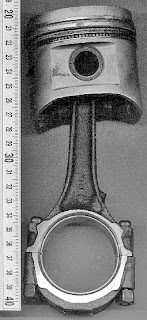The difference between S.I and C.I is that S.I is spark ignition and requires a spark plug where as a C.I is compression based and uses heat to ignite the fuel through compression.
Examples are the otto cycle(spark ignition) and the diesel cycle
The diesel engine was invented in 1893 by a german engineer by the name of Rudolf Diesel it was originally a air and oil mix in the first compression ignition.
the purpose of oil jest on the connecting rods is to spray the pumped oil into the bore of the engine it is sprayed on the thrust side of the bore.
The small end of the conrod is connected to the piston pin (aka gudgeon pin) and the big end of the conrod is connected to the bearing journal on the crankshaft.
With indirect injection on a diesel engine the injector inject's the diesel into what is refered to as a "pre-chamber" combustion begins here then moves to the main chamber this mean that there can be less pressure used in the injectors and allows for a quiter smoother running engine, unfortunatly this decreases the fuel effiency by 5-10%.
Where as with a direct injection diesel engine the injectors are mounted at the top of the combustion chamber spraying directly into the chamber at a higher pressure however they are noiser than indirect injection but do have 5-10% better fuel effiency.
the term valve timing means the exact time that the valve opens and closes for both inlet and exhaust valves and is usually run by a camshaft on a piston engine.
We have valve clearance in the engine so that when the inlet and exhaust valves are opening they dont hit the piston as that would badly damage the engine.










